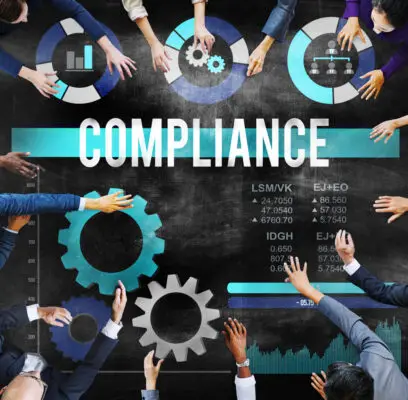Business risk management refers to the practices, processes, and policies a business implements to identify, assess, and mitigate risks that could prevent the organization from achieving its objectives.
It’s a proactive approach that seeks to manage the potential adverse effects of various internal and external factors on a company’s capital and earnings.
Key components of business risk management include:
- Risk Identification: Determining which risks could affect the business and documenting their characteristics.
- Risk Analysis: Understanding the nature of identified risks and their potential impact on the business.
- Risk Evaluation: Comparing estimated risks against risk criteria to determine their significance.
- Risk Treatment: Taking appropriate actions to mitigate or eliminate risks, including risk transfer (e.g., through insurance), risk avoidance, risk reduction, or risk acceptance.
- Risk Monitoring and Review: Continuously tracking existing risks, identifying new risks, and reviewing the effectiveness of risk management strategies.
- Communication and Consultation: Engaging with stakeholders to provide clear and timely information regarding risk management activities.
The ultimate goal of business risk management is to ensure that the organization understands its risks and has appropriate measures to handle them effectively.
This can help the business minimize losses, protect its reputation, comply with legal and regulatory requirements, and achieve its strategic objectives.
Effective business risk management can also provide a competitive advantage by allowing businesses to take calculated risks confidently, leading to innovation and growth.
It is a dynamic and ongoing process that requires constant attention, reflection, and adaptation to the ever-changing business environment.
In today’s complex and ever-changing business landscape, the importance of effective risk management cannot be overstated. Businesses face many risks, ranging from financial uncertainties to operational disruptions and regulatory compliance issues.

Organizations can proactively identify and mitigate potential threats by developing a comprehensive risk management strategy, safeguard their assets, and maintain a competitive advantage.
However, the key to successful risk management lies in understanding the types of risks businesses face and implementing best practices and strategies tailored to their specific needs.
So, what are the key components of effective risk management and how can organizations mitigate these risks? Let’s explore further.
Key Takeaways
- Business risk management is crucial for reducing overall risks and ensuring secure and stable operations.
- It enables better decision-making and increases efficiency in addressing threats and opportunities.
- Effective risk management safeguards assets and maintains a competitive advantage.
- Different types of business risks require tailored mitigation strategies and continuous monitoring and evaluation.
Importance of Business Risk Management
The importance of business risk management cannot be overstated. It plays a crucial role in reducing the overall risks a business faces, enabling it to operate in a more secure and stable manner.
Additionally, effective risk management facilitates improved decision-making and increases efficiency as potential threats and opportunities are identified and addressed proactively.
Reduction in entire risks of the business
Business risk management plays a critical role in safeguarding a company’s overall stability and success by effectively reducing its various risks.
This reduction in the entire risks of the business is crucial because it allows the organization to have better control over potential risks, minimizing their impact on the objectives and operations of the company.
Improved decision making
Effective business risk management is essential for enhancing decision-making processes and ensuring the long-term success of an organization.
Companies and organizations face various types of risks, including natural disasters and financial risks, which can significantly impact their operations.
Increases efficiency
By effectively managing risks, organizations can streamline their operations and optimize efficiency. This involves implementing policies and activities that focus on risk identification and mitigation.
Leaders play a crucial role in setting the tone and approach to risk management, ensuring that potential threats are proactively addressed.
Effective risk management plans enable organizations to identify and prioritize risks, allocate resources efficiently, and minimize potential disruptions.
Organizations can enhance their performance and achieve their objectives more effectively with a robust approach to managing risks.
Key Components of Effective Risk Management
Effective risk management requires implementing key components that help organizations identify, assess, and mitigate potential risks.
One important component is using various risk assessment techniques, such as conducting risk audits or utilizing risk matrices, to identify and prioritize potential risks.
Another key component is developing and implementing risk mitigation strategies, which involve taking proactive measures to minimize the impact and likelihood of identified risks.
Lastly, monitoring and evaluation play a crucial role in risk management by continuously assessing the effectiveness of implemented strategies and making necessary adjustments to ensure ongoing risk mitigation.
Risk Assessment Techniques
Risk assessment techniques are crucial components of a comprehensive risk management strategy. They help organizations identify and evaluate potential risks that could hurt their strategic objectives.

Risk Mitigation Strategies
Organizations can effectively manage risks by implementing proactive strategies that mitigate potential negative impacts on their strategic objectives.
Risk mitigation strategies involve identifying and addressing potential risks before they occur. This can be done through risk acceptance, where the organization accepts the risk and its potential losses, or risk avoidance, where it takes steps to avoid the risk altogether.
Risk categories can include financial risks, security risks, and internal risks. A risk management committee within the organization can oversee and implement the risk management strategy.
| Risk Acceptance | Risk Avoidance | Risk Categories |
|---|---|---|
| Accepting potential losses | Taking steps to avoid risks | Financial risks |
| Assessing cash flow impact | Implementing security measures | Security risks |
| Evaluating potential consequences | Addressing internal control weaknesses | Internal risks |
Monitoring and Evaluation
Monitoring and evaluation are essential components of a comprehensive risk management strategy, providing organizations with valuable insights into the effectiveness of their risk mitigation efforts.
To evoke emotion in the audience, consider these three key aspects of monitoring and evaluation:
1) Identifying potential risks and their financial impact.
2) Assessing the adequacy of risk management teams and their mitigation plans.
3) Evaluating the effectiveness of employee training in minimizing damage caused by events such as storm damage or cyber-attacks.
These insights enable business leaders to make informed decisions and take proactive measures to protect their business activities.
Types of Business Risks
In the realm of risk management, it is crucial to understand the various types of business risks that organizations may face. These risks can be categorized into five main types:
- operational risks,
- strategic risks,
- external risks,
- financial risks, and
- physical risks.
Each type of risk presents its own unique challenges and requires tailored mitigation strategies to minimize potential negative impacts.
Operational risks
Operational risks are a critical aspect of business management, encompassing the potential hazards and vulnerabilities that may arise from internal processes, systems, and external factors.
To effectively address these risks, boards of directors and senior management must implement robust enterprise risk management strategies.
This includes identifying and mitigating preventable risks through the use of a risk register, conducting regular assessments of key risks, and implementing strong third-party risk management protocols.
A thorough business impact analysis section can also help identify and address competitive risks that may impact the organization’s operations.
Strategic risks
Strategic risks are a fundamental aspect of business management, encompassing the potential uncertainties and challenges arising from the organization’s long-term decisions, competitive landscape, and external market factors.
These risks can manifest as risk events that have the potential to impact the organization’s performance and success.
Effective business risk management involves identifying, assessing, and mitigating these strategic risks. Categories of risks include acceptance of strategy risks, critical risks, and external risk threats. Business unit leaders must prioritize strategic risk management to ensure regulatory compliance and minimize the effects of risk.
External risks
External risks are critical in business risk management, encompassing factors outside the organization that can impact its operations and performance. These risks include:
- Drug abuse and hazardous materials, can pose significant threats to employee safety and well-being.
- Economic downturns can lead to decreased demand for products or services and financial burdens.
- Geopolitical risks, such as political instability or trade disputes, can disrupt global supply chains and hinder business operations.
Identifying and managing these external risks is an ongoing process that involves enterprise risk management teams and a functional leader.
Financial risks
Financial risks are a crucial aspect of business risk management and encompass various types of risks that can impact a company’s financial stability and performance.
To mitigate these risks, companies must establish robust internal controls, implement effective financial controls, and comply with compliance processes.
Physical risks
Physical risks are inherent in business operations and can pose significant challenges to a company’s ability to maintain its operations, assets, and workforce.
These risks can range from natural disasters to harmful events caused by external or internal policies.
To mitigate these risks, complex organizations must implement a systematic process that includes checks on employees, robust disaster preparedness measures, and establishing internal policies to prevent financial losses.
Failure to address physical risks can pose an existential threat to business units.
Strategies for Mitigating Business Risks
Implementing effective risk management strategies is crucial for businesses to safeguard their operations and ensure long-term success.
Organizations should adopt a holistic approach that encompasses the entire organization to mitigate business risks. This includes incorporating risk management into the business plan, seeking guidance from a risk management consultant, and moving away from traditional risk management programs.
Effective risk oversight, led by a chief risk officer, should focus on identifying and managing risks, while contingency planning should be implemented to mitigate the impact of economic disasters.
Best Practices for Implementing Risk Management Processes
To effectively implement risk management processes, organizations should focus on two key aspects: risk assessment methods and mitigation strategies.
Risk assessment methods involve identifying and analyzing potential risks that may impact the organization, while mitigation strategies involve developing and implementing measures to minimize or eliminate those risks.
Risk Assessment Methods
Effective risk management requires the use of robust and reliable methods for assessing potential risks and implementing appropriate mitigation strategies. To ensure success in risk assessment, consider the following approaches:
- Utilize advanced analytics and data modeling techniques to identify potential business venture and supply chain risks.
- Embrace positive risks that can lead to growth and innovation while balancing the need to mitigate critical risk events.
- Implement comprehensive control processes and compliance services to effectively manage franchise risk and extended networks.
Mitigation Strategies
Organizations must adopt proven strategies that effectively address potential threats and vulnerabilities to manage risk successfully.
One such strategy is forming a central risk team responsible for overseeing risk management processes and ensuring alignment with company goals.
This team works closely with silo leaders to identify and assess risks, implementing mitigation strategies to minimize their impact.
Risk management is crucial in industries such as e-commerce and city planning, and roles at both the C and granular levels are essential for effective decision-making activities.
| Risk Management | Central Risk Team | Silo Leaders |
|---|---|---|
| Align with goals | Oversee processes | Identify risks |
| Minimize vulnerabilities | Assess risks | Implement strategies |
| Optimize decision-making | Coordinate efforts | Collaborate closely |
Frequently Asked Questions
How Does Business Risk Management Impact the Overall Success and Profitability of a Company?
Effective business risk management plays a crucial role in determining a company’s overall success and profitability.
Organizations can safeguard their assets, maintain financial stability, and make informed strategic decisions by identifying, analysing, and mitigating potential risks.
Are There Any Legal or Regulatory Requirements That Businesses Must Follow in Regard to Risk Management?
Yes, there are legal and regulatory requirements that businesses must follow in regard to risk management.
These requirements ensure that businesses identify, assess, and mitigate risks effectively, thus safeguarding stakeholders and complying with applicable laws and regulations.
How Can Businesses Identify and Assess Potential Risks That May Arise in Their Industry or Market?
Businesses can identify and assess potential risks that may arise in their industry or market through comprehensive risk analysis and evaluation.
This involves conducting thorough research, analyzing industry trends, and assessing various risks’ potential impact and likelihood.
What Are Some Common Challenges or Obstacles Businesses Face When Implementing Risk Management Processes?
Some common challenges or obstacles businesses face when implementing risk management processes include a lack of awareness or understanding of risk management, limited resources, resistance to change, and difficulty identifying and prioritizing risks.
How Can Businesses Measure and Monitor the Effectiveness of Their Risk Management Strategies Over Time?
Businesses can measure and monitor the effectiveness of their risk management strategies over time by regularly assessing key risk indicators, conducting internal and external audits, analyzing incident reports, and benchmarking against industry best practices.

Conclusion
Effective risk management is crucial for businesses to mitigate potential risks that may affect their operations and objectives.
Businesses can minimize various types of risks, such as financial, operational, strategic, and compliance risks, by implementing comprehensive risk management processes.
Adopting best practices in risk management can further strengthen an organization’s ability to navigate uncertainties and make informed decisions to achieve sustainable success.

Chris Ekai is a Risk Management expert with over 10 years of experience in the field. He has a Master’s(MSc) degree in Risk Management from University of Portsmouth and is a CPA and Finance professional. He currently works as a Content Manager at Risk Publishing, writing about Enterprise Risk Management, Business Continuity Management and Project Management.

